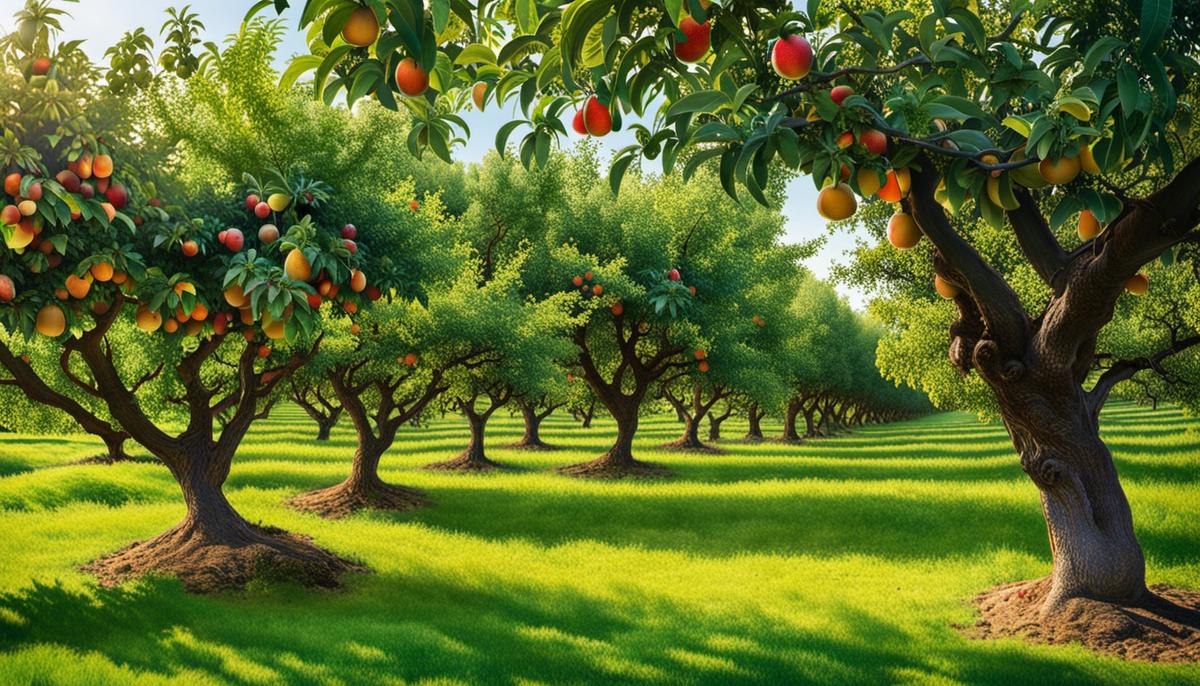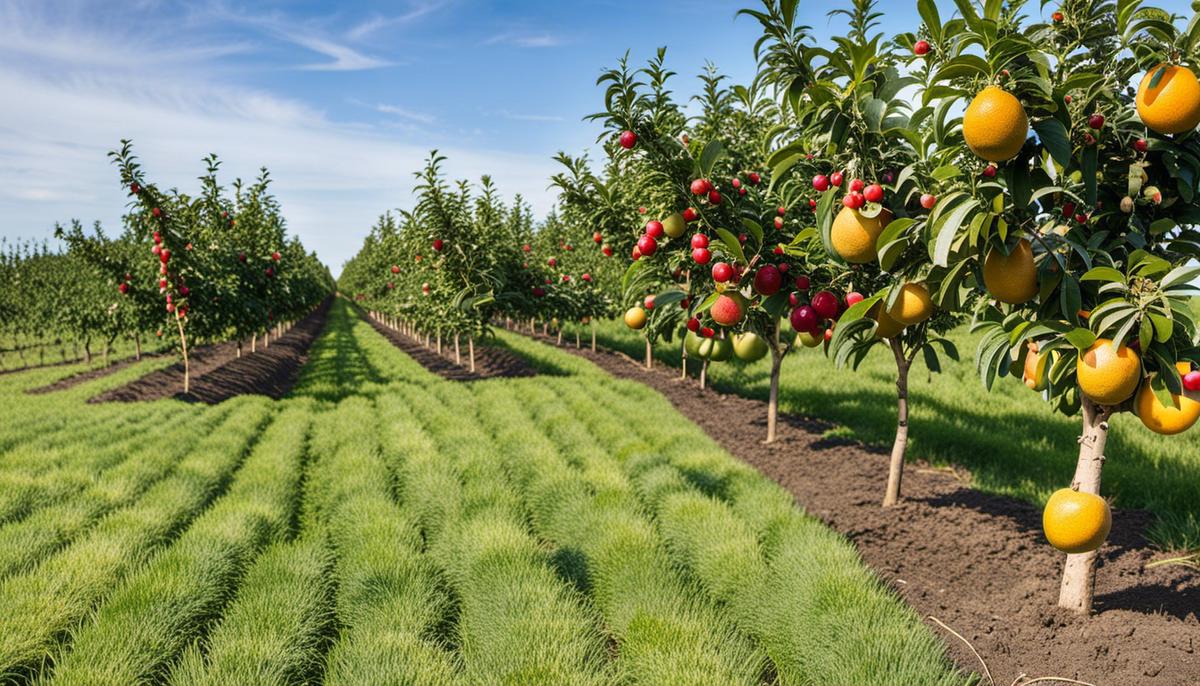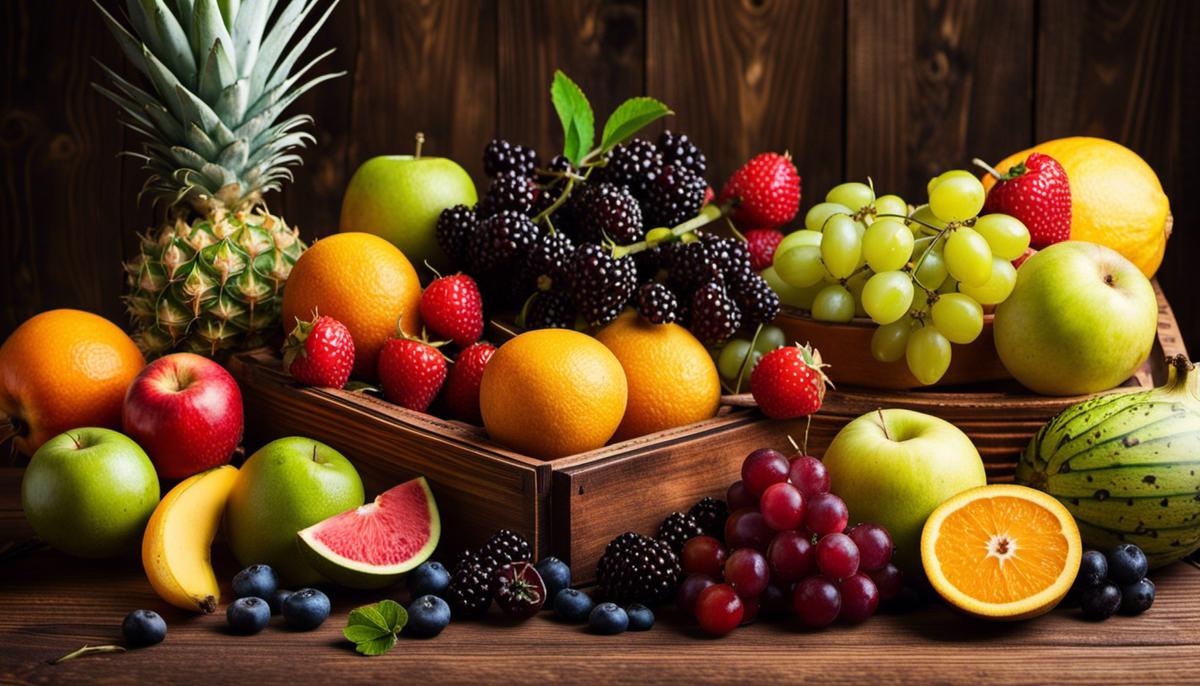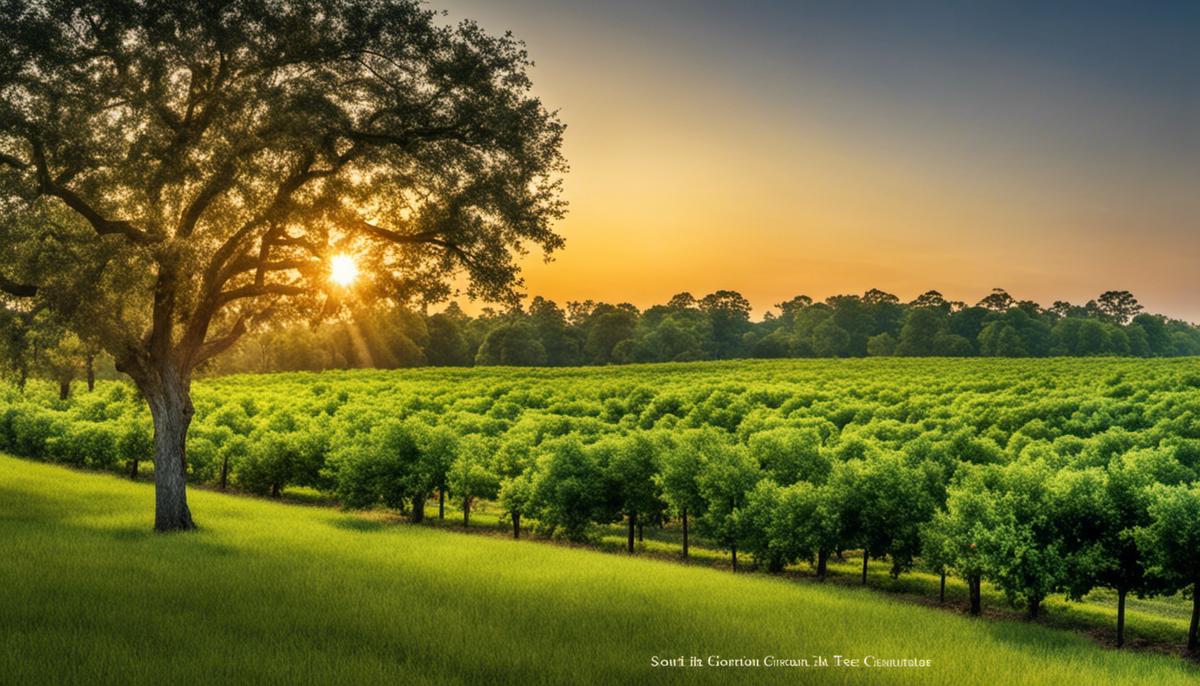Fruit cultivation has long been an integral part of South Carolina’s horticultural heritage, mirroring its diverse climate and fertile soils. From lush peach orchards to robust apple trees, the landscape of the state speaks volumes about its traditional and local farming practices.
However, the types of fruit trees that thrive in South Carolina aren’t just limited to these well-known varieties. This comprehensive analysis seeks to shed light on both historically favored fruit trees, and those which have been newly introduced or under experimental cultivation.
Attention will also be paid to the best cultivation practices for these trees and the consequent economic and ecological impact this industry has on the state and its residents.
What fruit trees grow in South Carolina
Understanding the Climate of South Carolina
South Carolina is characterized by a humid subtropical climate, where temperatures typically range from 86 to 90 degrees in summer and 32 to 60 degrees in winter. The state experiences average annual precipitation of approximately 49.8 inches, evenly distributed throughout the year.
The state is divided into three primary regions – the Blue Ridge region, which is the most elevated and the coolest, the Piedmont region, which has moderate conditions, and the Coastal Plain region, which has the warmest temperatures.
Importance of Humidity, Temperature, and Precipitation Levels in Tree Growth
Humidity, temperature, and precipitation are crucial factors that influence tree growth. High humidity and moderate temperatures help evoke the distinctive flavors in fruits. Adequate rainfall is significant for tree growth as it supplements the groundwater and caters to a tree’s water needs. Temperatures influence the dormancy periods and flowering times of fruit trees. Some trees need winter chill hours to induce fruiting while others thrive in warmer climates.
Microclimates and Fruit Tree Growth
Microclimates, smaller areas within a general climate zone where conditions vary, can significantly influence what trees can grow in a region. In South Carolina, the presence of microclimates within the Blue Ridge, Piedmont, and Coastal Plain regions allows a wider variety of fruit trees to thrive. Proximity to water bodies, variation in terrain, and different altitudes can create microclimates within the state.
Fruit Trees Thriving in South Carolina’s Climate
Due to the favorable climate and variety of microclimates in South Carolina, a broad assortment of fruit trees can successfully grow in the region. Trees that produce peaches, apples, pears, plums, persimmons, and figs are common throughout the state.
Peach trees, the state fruit, thrive particularly well here and South Carolina is the second-largest peach-producing state in the U.S. Apples favor the cooler elevations of the Blue Ridge region. Pears, plums, and persimmons enjoy the milder climates of the Piedmont and Coastal Plain regions, with certain species adaptable enough to grow throughout the entire state.
Fig trees prefer the warmer coastal region. Pawpaw, pomegranates, and citrus fruits like satsuma oranges and kumquats also grow successfully in some warmer parts of the state due to the presence of favorable microclimates.
Understanding the unique needs of fruit tree varieties is vital for their successful cultivation. Particular considerations include the specific number of ‘chill hours’ each tree requires, the suitability of different planting zones, and the varying nature of soil types.

Historical and Currently Thriving Fruit Trees
Peach Trees: South Carolina’s Delight
Peaches, associated heavily with South Carolina and often called the “Tastier Peach State”, thrive spectacularly in the region’s warm climate which stimulates abundant blossoms. These trees have been a hallmark of South Carolina’s agriculture for nearly 150 years. Each type of peach tree demands varying chill hours – a period of winter chill vital to end their dormancy. Some of the widely grown peach varieties in South Carolina include Early Amber, Georgia Belle, and Elberta.
Apple Orchards and Varieties
While often overshadowed by the state’s peach production, apples are a historic fruit in South Carolina’s overall horticulture. Primarily grown in Upstate’s mountain counties due to the need for colder winters to break dormancy, the state is home to an array of popular apple variants such as King Luscious, Magna Bonum, Blacktwig, and Limbertwig.
Age-long Citrus and Satsuma Oranges
Citrus is a lesser-known element of South Carolina’s fruit-growing history, albeit a remarkable one. The Satsuma Orange, or cold-hardy citrus, resists cooler temperatures and ice damage, making it suitable for South Carolina’s colder coastal plain locales.
Fruit Disease and Pest Trends
Fruit disease and agricultural pests have played a significant role in the cultivation of fruit trees in South Carolina. Peach growers have to contend with an array of diseases and pests such as Brown Rot, Bacterial Spot, and Peach Tree Borer. Regular inspections and thorough maintenance are crucial to successful peach harvests.
Apple trees face similar challenges, with diseases like Apple Scab and Ceder-Apple Rust, and pests like Codling Moth and Apple Aphid wreaking havoc on an otherwise fruitful harvest. This necessitates periodic spraying and vigilant upkeep.
Similarly, citrus trees namely Satsuma Orange trees, aren’t spared from diseases and pest threats like the Asian Citrus Psyllid insect which spreads the Citrus Greening Disease, greatly diminishing the tree’s health and fruit production. Managing these threats often involves implementing Integrated Pest Management (IPM) practices that encompass a combination of biological control, the use of resistant tree varieties, and careful application of pesticides.
Other Fruit Trees in South Carolina: Plums, Pears, and Figs
The rich diversity of South Carolina’s climatic conditions nurtures the growth of a variety of fruit trees. Plum trees, notably the Japanese variant, have seen successful growth, largely in home orchards. An array of pear varieties are also well suited to the South Carolina climate, including tropical pineapple pear and the Orient pear. In addition, fig trees are thriving, with ‘Celeste’ and ‘Brown Turkey’ varieties producing bountiful crops.
Although these fruit trees aren’t as common as peach or apple trees, they do play a vital role in the horticultural scenery of South Carolina. They each share the challenges of coping with different pests and diseases, thus necessitating strong, flexible disease and pest management strategies. A comprehensive understanding of these threats can improve fruit tree management resulting in healthier trees and more abundant harvests.

Newly Introduced and Experimental Fruit Trees
Introduction of Persimmon Trees in South Carolina
In an interesting twist, horticulturists and farmers in South Carolina have recently begun experimenting with planting Oriental persimmons. This hardy tree shows high resistance to pests and diseases, making it a promising addition to the region’s fruit bounty.
The fruit it bears offers a sweet, honey-like taste, which is a growing favorite among health aficionados. As the early trials with persimmons have largely shown positive results, their cultivation might become more widespread among South Carolina’s farmers in the near future.
Trying Out Asian Pears in South Carolina
Asian pears, also known as Nashi pears, are high in demand due to their fresh, crisp texture and sweet taste. They are not traditionally grown in South Carolina, but presently, agricultural experts are experimenting with a few varieties with promising results.
The pear tree is a bit more temperature-sensitive, but with careful site selection and proper cultivation practices, it seems to be effectively growing in South Carolina’s soils.
Potential for Cultivating Figs in South Carolina
The fig tree is an exotic addition to the traditional fruit tree spectrum of South Carolina. Horticultural trials are ongoing to test the adaptability of different fig varieties in the unique soil and climatic conditions of South Carolina.
The fig tree is resistant to temperature fluctuations, making it a promising candidate for cultivation in the region, where summers can be quite hot. If successful, the trials could add to the fruit crop diversity in South Carolina.
Australia’s Illawarra Plum’s Growth Potential
Despite being native to Australia, the Illawarra plum has recently been introduced to South Carolina. This tree produces a unique plum with a deep red exterior and a distinctively rich, sweet flavor. Initial cultivation attempts suggest that this plum tree variety is adaptable to South Carolina’s climate. The potential success of this fruit tree could provide new products and revenue streams for South Carolina growers.
Finger Limes: A Novelty to South Carolina’s Fruit Tree Spectrum
Known for their caviar-like fruiting bodies, finger limes have become the new sensation among fruit enthusiasts and chefs. South Carolina has seen recent attempts to introduce this citrus variety into its agricultural landscape. So far, the finger lime trees are showing promising growth rates, indicating potential successful cultivation in the coming years.
Potential of Pomegranate in South Carolina
The pomegranate tree is highly drought-resistant and can produce fruit even under harsh conditions. It is one of the fruit trees under experimentation in South Carolina due to its resilience and adaptability. It’s an excellent source of antioxidants and is popular among health-conscious individuals. Although traditionally grown in arid regions, preliminary reports show promise for its growth and production in South Carolina.
Introducing the Kiwi Berry: A Novel Addition to South Carolina’s Fruit Family
Unfamiliar to most, the kiwi berry is a grape-sized variant of the traditional kiwi fruit, boasting a taste that is sweeter and less sharp. This unusual fruit has recently become the target of cultivation experiments in South Carolina, where it’s being tested as a potential new addition to the state’s agricultural offering.
With their high nutritional profile and popularity in the health food circles, kiwi berries bring an intriguing new perspective to the state’s ever-growing fruit tree cultivation efforts.

Cultivation Best Practices for South Carolina Fruit Trees
Abundant Variety: A Look at South Carolina’s Fruit Trees
Thanks to its hospitable climate, South Carolina is home to a broad array of fruit trees. The state’s southern regions, falling within zones 8-9, are particularly conducive to growing a variety of fruits like peaches, persimmons, figs, Asian pears, pomegranates, and even citrus fruits.
However, its cooler northern areas (zones 6-7) shouldn’t be discounted, as they provide an ideal environment for apples, cherries, plums, and several nut types. This impressive variety underlines the rich diversity of South Carolina’s fruit tree cultivation efforts.
Peaches: The South Carolina Staple
South Carolina is the nation’s second-leading producer of peaches, after California. The state’s sandy, well-drained soil and long growing season are perfect for peach orchards. Varieties like ‘O’Henry’, ‘Redhaven’, and ‘Cresthaven’ thrives best in this region. Successful peach farmers, such as Watsonia Farms and McLeod Farms, prune effectively to maximize sun penetration and air movement in the tree canopy.
Apple Orchards in the Upstate Region
The Upstate region of South Carolina, with its cooler temperatures and high elevations, is home to thriving apple orchards. Varieties like ‘Gala’, ‘Golden Delicious’, and ‘Fuji’ are common. To ensure a successful harvest, apple growers like Sky Top Orchard and Chattooga Belle Farm, focus on regular pruning, adequate spacing for growth, and disease management through modern farming techniques.
Berries and Small Fruits: A Farm-to-Table Favorite
Blueberries, strawberries, blackberries, and raspberries also do well in South Carolina. These small fruits are commonly used in farm-to-table restaurants and local food initiatives due to their versatility and high demand. Local farms like Lever Farms and Happy Berry cultivate these vibrant berries organically, practicing crop rotation and deploying beneficial insects to manage pests.
Citrus, Pomegranates, and Fig Trees: Expanding Horizons
Recent years have seen an increase in South Carolinian farmers venturing into growing citrus, pomegranates, and figs. These trees thrive in the coastal region where winters are mild. The citrus industry, although still in its infancy, shows promise with the successful cultivation of ‘Meyer’ lemons and ‘Satsuma’ mandarins.
Best Practices for Cultivating Fruit Trees in South Carolina
Regardless of the type of fruit tree, local practitioners recommend a host of best practices for cultivation in South Carolina. These include selecting the right variety for the region, ensuring appropriate planting depth and spacing, religiously pruning and fertilizing, and regularly monitoring for disease and pests.
The practices are enhanced by utilizing local extension resources, employing professional arborists and horticulturists, and participating in knowledge-sharing farm networks.
The state of South Carolina boasts a diverse and thriving fruit tree landscape, primarily due to its evolving climate and advancements in agricultural technology. Keeping pace with current horticultural trends and employing responsible and innovative farming practices is key to success in fruit tree cultivation here.

Economic and Ecological Impact of Fruit Tree Growth
Economic Influence of Fruit Tree Cultivation in South Carolina
The fruit tree farming industry significantly bolsters South Carolina’s economy, supporting a multitude of jobs across the agricultural sector. This extends from on-ground farm workers and packers to those involved in selling agricultural machinery, transportation, and retail grocery employees.
As per reports from the South Carolina Department of Agriculture, the overall agriculture sector, including fruit tree farming, contributes an astounding $46.2 billion to the state’s economy and is directly responsible for about 245,000 jobs.
In particular, peach farming stands out as a vital fruit tree industry in the Palmetto State. Being the second-largest provider of peaches in the United States and accounting for handily 15% of the national peach yield, South Carolina’s approximately 14,000 acres of peach orchards annually produce a hefty 80 million pounds of peaches. Their influence hence reverberates throughout the local and national markets, underlining their economic significance.
Ecological Impact of Fruit Tree Farming in South Carolina
Fruit tree farming also has distinctive ecological impacts. For instance, orchards can contribute positively to soil health. The roots of fruit trees reach deep into the ground, drawing nutrients from the soil; in turn, decomposing fallen fruit, leaves, and pruned branches return organic matter, promoting a healthy soil biota.
Moreover, fruit tree orchards cultivate more diverse habitats than annual crops by offering a variety of flowering and fruit-bearing species attracting a myriad of beneficial insects and birds, and enhancing biodiversity.
However, fruit tree farming also poses ecological challenges. High demands for certain fruits can lead to monoculture farming, which can adversely affect biodiversity and deplete soil nutrients. Additionally, conventional fruit farming often requires large amounts of pesticides and synthetic fertilizers, which can harm local water bodies and native plant and animal species.
Local communities in South Carolina typically participate in fruit tree farming in various capacities. Many operate family-owned fruit farms passed down over generations, contributing significantly to the state’s agriculture sector.
Farmers’ markets play an essential part in this, offering a platform for small-scale producers to sell directly to consumers, ensuring locally grown fruits’ availability.
With a growing awareness of ecological sustainability, many fruit tree farmers are also adopting sustainable farming practices. Organically grown fruits, integrated pest management techniques, and crop rotation are some methods employed to decrease the environmental impact of fruit tree farming while also improving soil health and sustaining crop yield.
Some farms also invite community engagement through activities like pick-your-own adventures, helping educate the public about locally sourced produce and sustainable farming techniques, thereby fostering a relationship between agriculture and the broader community.
Economic and Ecological Impact of Fruit Tree Growth in South Carolina
All in all, fruit tree growth in South Carolina presents unique opportunities and challenges economically and ecologically. By understanding and managing these impacts, fruit tree farming in the state can continue to be a robust industry while safeguarding the environment.

Taking all the discussed components into account, it is evident that South Carolina’s diverse climatic conditions and the adaptability of its farmers bring forth an array of fruitful possibilities.
Understanding and adapting to the challenges posed by pests, diseases, and climate changes, local horticulturists have demonstrated resilience and creativity in their cultivation practices.
More than just creating economic value, the culture of fruit cultivation also lends itself to the enhancement of South Carolina’s biodiversity and soil health, propelling the state’s sustainability practices forward.
The future of fruit tree cultivation in South Carolina, thus, promises to be as rich and vibrant as its present, bearing the fruits of labor, innovation, and sustainable practices.







